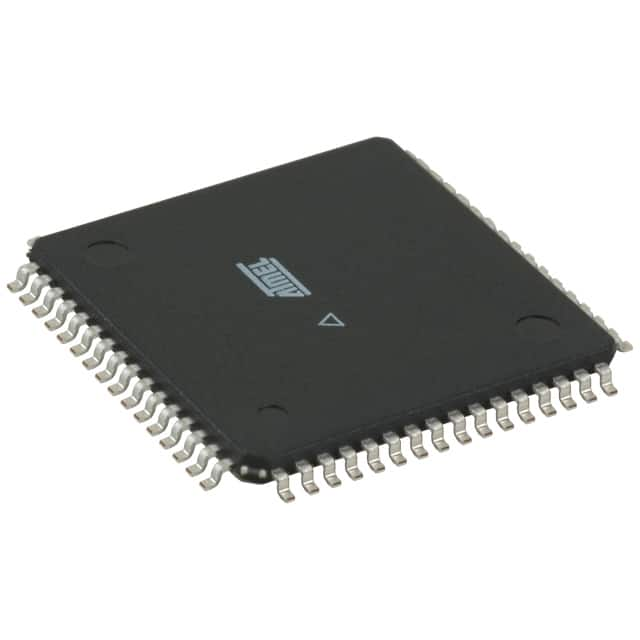ATMEGA64-16AI
Product Overview
Category
ATMEGA64-16AI belongs to the category of microcontrollers.
Use
It is widely used in various electronic applications that require a microcontroller for processing and controlling tasks.
Characteristics
- High-performance microcontroller with advanced features
- Low power consumption
- Wide operating voltage range
- Large program memory capacity
- Multiple communication interfaces
- Rich set of peripherals
Package
ATMEGA64-16AI is available in a 64-pin package.
Essence
The essence of ATMEGA64-16AI lies in its ability to provide efficient and reliable control and processing capabilities for electronic devices.
Packaging/Quantity
ATMEGA64-16AI is typically packaged in reels or tubes, with a quantity of 250 units per reel/tube.
Specifications
- Microcontroller architecture: AVR
- Operating voltage: 2.7V to 5.5V
- Flash program memory: 64KB
- RAM: 4KB
- EEPROM: 2KB
- Number of I/O pins: 53
- Communication interfaces: UART, SPI, I2C
- Analog-to-Digital Converter (ADC): 8 channels, 10-bit resolution
- Timers/Counters: 3 timers/counters
- Operating temperature range: -40°C to +85°C
Detailed Pin Configuration
The pin configuration of ATMEGA64-16AI is as follows:
- VCC
- GND
- Port A0
- Port A1
- Port A2
- Port A3
- Port A4
- Port A5
- Port A6
- Port A7
- Port C0
- Port C1
- Port C2
- Port C3
- Port C4
- Port C5
- Port C6
- Port C7
- Port D0
- Port D1
- Port D2
- Port D3
- Port D4
- Port D5
- Port D6
- Port D7
- Port B0
- Port B1
- Port B2
- Port B3
- Port B4
- Port B5
- Port B6
- Port B7
- Reset
- XTAL1
- XTAL2
- AVCC
- AREF
- GND
- Port F0
- Port F1
- Port F2
- Port F3
- Port F4
- Port F5
- Port F6
- Port F7
- Port G0
- Port G1
- Port G2
- Port G3
- Port G4
Functional Features
- High-speed processing capability
- Multiple communication interfaces for data exchange
- Flexible I/O configuration
- Analog-to-Digital Converter for sensor interfacing
- Timers/Counters for precise timing operations
- Interrupt handling mechanism for real-time event handling
- Power-saving modes for efficient energy consumption
Advantages and Disadvantages
Advantages
- Powerful microcontroller with advanced features
- Wide operating voltage range allows compatibility with various power sources
- Large program memory capacity enables complex applications
- Rich set of peripherals provides versatility in application development
- Low power consumption for energy-efficient designs
Disadvantages
- Limited number of I/O pins may restrict the connectivity options in some applications
- Relatively higher cost compared to simpler microcontrollers
Working Principles
ATMEGA64-16AI operates based on the AVR microcontroller architecture. It executes instructions stored in its program memory to perform various tasks. The microcontroller interacts with external devices through its I/O pins and communication interfaces. It can process data, control peripherals, and respond to events using its internal resources.
Detailed Application Field Plans
ATMEGA64-16AI finds applications in a wide range of fields, including but not limited to: - Industrial automation - Home automation - Robotics - Internet of Things (IoT) devices - Automotive electronics - Medical devices - Consumer electronics
Detailed and Complete Alternative Models
Some alternative models to ATMEGA64-16AI that offer similar functionalities are: - ATMEGA128-16AU - ATMEGA2560-16AU - PIC18F4550 - STM32F407VG
These alternative models provide comparable features and can be considered as substitutes depending on specific requirements.
In conclusion, ATMEGA64-16AI is a high-performance microcontroller with advanced features, suitable
Senaraikan 10 soalan dan jawapan biasa yang berkaitan dengan aplikasi ATMEGA64-16AI dalam penyelesaian teknikal
Sure! Here are 10 common questions and answers related to the application of ATMEGA64-16AI in technical solutions:
Q: What is ATMEGA64-16AI? A: ATMEGA64-16AI is a microcontroller from the AVR family, manufactured by Atmel. It has 64KB of flash memory, 4KB of SRAM, and operates at 16MHz.
Q: What are the key features of ATMEGA64-16AI? A: Some key features of ATMEGA64-16AI include 64KB of programmable flash memory, 4KB of SRAM, 32 general-purpose I/O pins, multiple communication interfaces (UART, SPI, I2C), and built-in analog-to-digital converters (ADC).
Q: What are some typical applications of ATMEGA64-16AI? A: ATMEGA64-16AI is commonly used in various embedded systems applications such as industrial automation, robotics, home automation, consumer electronics, and automotive systems.
Q: How can I program ATMEGA64-16AI? A: ATMEGA64-16AI can be programmed using various programming languages like C or assembly. You can use an Integrated Development Environment (IDE) like Atmel Studio or Arduino IDE, along with a suitable programmer/debugger.
Q: Can I interface ATMEGA64-16AI with other devices? A: Yes, ATMEGA64-16AI supports multiple communication interfaces like UART, SPI, and I2C, which allows you to easily interface it with other devices such as sensors, displays, and actuators.
Q: What is the maximum clock frequency supported by ATMEGA64-16AI? A: ATMEGA64-16AI can operate at a maximum clock frequency of 16MHz.
Q: Does ATMEGA64-16AI have built-in analog-to-digital converters (ADC)? A: Yes, ATMEGA64-16AI has an 8-channel, 10-bit ADC module that allows you to convert analog signals into digital values for processing.
Q: Can I use ATMEGA64-16AI in battery-powered applications? A: Yes, ATMEGA64-16AI is designed to be power-efficient and can be used in battery-powered applications. It has various power-saving modes that help reduce power consumption.
Q: Is ATMEGA64-16AI suitable for real-time applications? A: Yes, ATMEGA64-16AI can be used in real-time applications as it has features like interrupt handling, timers, and PWM outputs that are essential for real-time control.
Q: Are there any development boards available for ATMEGA64-16AI? A: Yes, there are development boards available specifically designed for ATMEGA64-16AI, such as Arduino Mega or custom-made boards. These boards provide easy access to the microcontroller's pins and additional features for rapid prototyping.
Please note that the specific details and answers may vary depending on the context and requirements of your technical solution.


